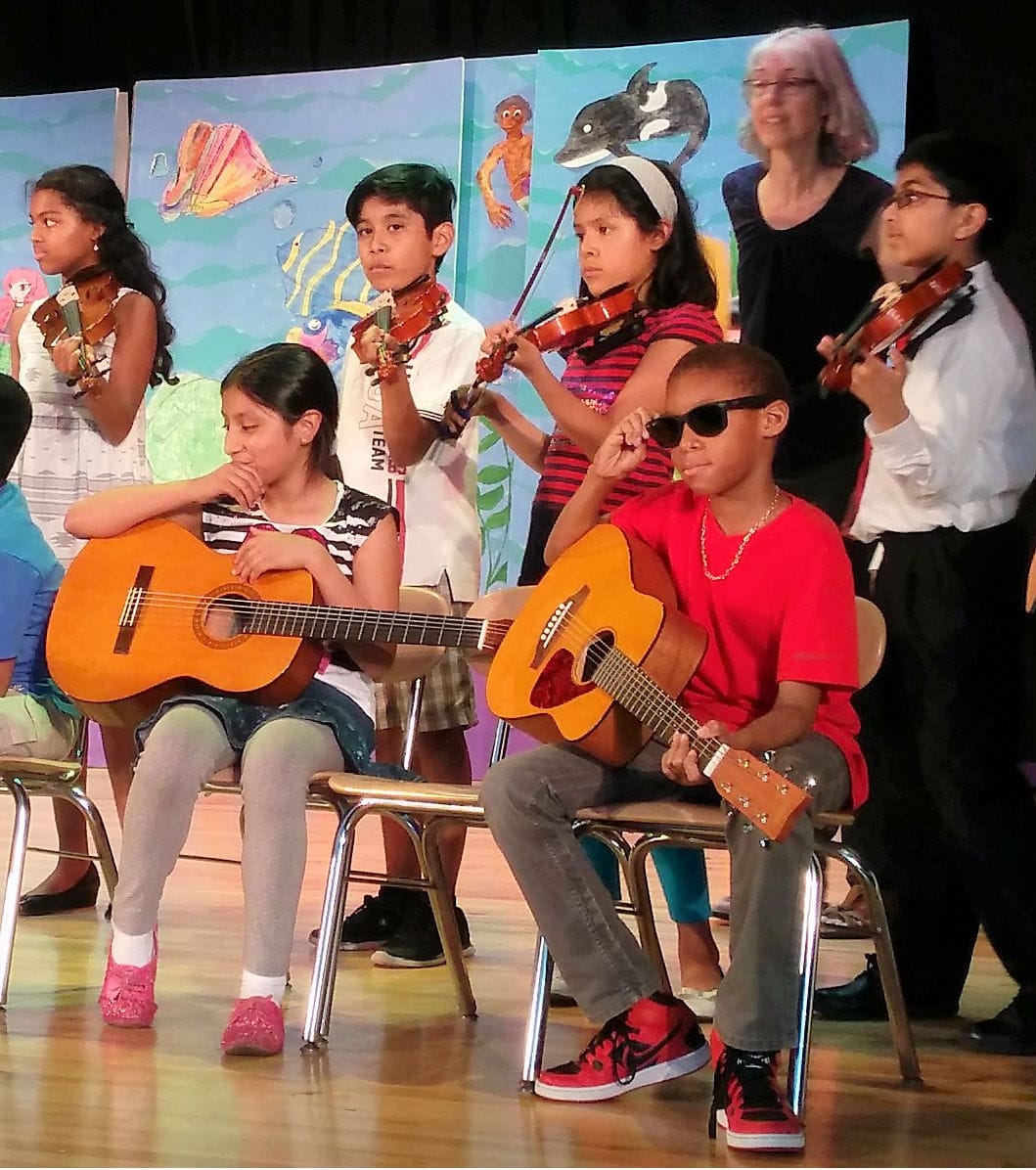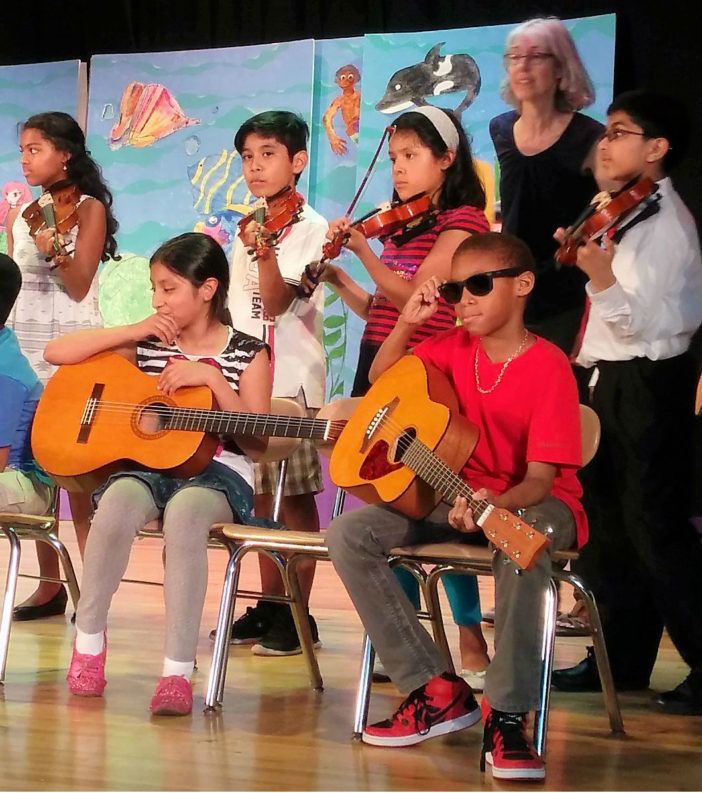The Music Program That Makes PS 217 Students Swing


The first spring recital of P.S. 217’s Afro Latin Jazz Alliance’s Academy of Music (ALJAM) ended on a high note. But perhaps the most impressive part of that May 31 night was that all 23 student performers sounded that note in time, together.
“You can’t play this music alone in a room,” said Arturo O’Farrill, Grammy-winning artist and founder of the Afro Latin Jazz Alliance. “This is ensemble music. You have to play with other people. And the most important thing is you can’t play music with other people unless you listen, unless you hear them, unless you let them also lead.”
O’Farrill is the son of trumpeter and composer Chico O’Farrill, who was originally from Havana, Cuba. Arturo O’Farrill was born in Mexico City but moved to New York as a child and grew up here.
O’Farrill formed the Alliance in 2007 “to preserve, educate and perform the music of Afro-Latin Jazz.” The Alliance’s ALJAM program uses music as an entry point to teach deeper lessons, including self-respect and the significance of culture.
“When you care about other people, you change yourself in the process,” he said.
That lesson echoed onstage at the spring recital, which featured 4th and 5th graders playing instruments they picked up just seven months prior, when ALJAM was launched at P.S. 217. They began the program as eager, hard-working students. But by the recitals finale, when these newfound guitarists, pianists, trumpeters, sax players and percussionists tackled “Viva la Escuela!” and “Afro Blue”, they were an orchestra; gloriously more than the sum of its parts.

The ALJAM program at P.S. 217 had its genesis at the local Halloween parade on Glenwood Road, according to Joel Siegel, President of the Ditmas Park West Association and a P.S. 217 parent. Siegel is also a musician, and his band had a regular gig at the Halloween parade. But he’d been looking to pass the baton. “I was always thinking, ‘Geeze, we shouldn’t be playing at this Halloween Parade, we should have a kids band,’” Siegel said.
When City Council member Mathieu Eugene, chair of the Youth Services Committee, asked Siegel to suggest a local youth program, Siegel brought up his idea: a band program for students at P.S. 217.
Eugene helped turn this idea into a real opportunity. “All education should include training in the arts, and I’m so pleased to allocate funding to the Afro Latin Jazz Alliance program at P.S. 217,” he said. “Our children need to have a balanced academic life, and that means including music classes into educational studies.”
With City Council funding secured, Siegel said, “then I was really in a pickle because now my councilman was telling me I had the money and I’m like, ‘Oh no, now what do I do?’”
Siegel contacted the Afro Latin Jazz Alliance, which already ran education programs in several New York schools. The Alliance agreed to bring its after-school program to Ditmas Park.
At the spring recital, O’Farrill told the audience that he pursued a career in jazz because he was inspired by musicians who visited his school when he was young. Those performers told him that even if they played a song hundreds of times, it was always a different experience. That concept struck a chord in him, and he’s been playing ever since; from his first breakthrough gig with Carla Bley at age 19, to playing with artists like Dizzy Gillespie and Lester Bowie.
But it wasn’t until the 1990s that he embraced his Latin roots and began performing primarily in Afro-Latin jazz.
O’Farrill saw that many contemporary jazz musicians didn’t have the training or experience to play Latin numbers, so he started the Afro Latin Jazz Alliance as a non-profit organization to “preserve the music and heritage of big-band Latin jazz.” The Alliance supports the work of his Afro Latin Jazz Orchestra (which supplements traditional jazz big band instrumentation with a Cuban percussion ensemble), whose goal is to bring jazz education into public schools.
For its first year at P.S. 217, the ALJAM program had seven teachers and 30 students.
Albert Marquès, head teacher for the school’s program said, “We teach trumpet, saxophone, violin, piano, guitar and percussion. Most of the students have never seen any instrument. First we show them how each instrument sounds and then they choose.”
The program includes music theory instruction and hands-on instrument lessons. “New York public schools don’t offer an artistic or musical education most of the time,” Marquès explained, “I love jazz and latin-jazz, but mostly I’m just happy to make sure that students without the resources to have private lessons will get a good musical education.”
Marquès finds that the program gives students a chance to celebrate their heritage rather than leaving it behind. “So many of our students have a Hispanic heritage and some of the teachers (like myself) are Hispanic. I feel that some of my Latino students don’t feel proud enough of their roots. So many times, their parents don’t even teach them Spanish at home because they want them to become ‘Americans’. Thanks to this program we can show them internationally recognized Latin American musicians and also make them discover a music that comes from their culture”
Siegel agreed that the program is the perfect fit for a culturally diverse neighborhood school where many students are children of immigrants.
He treasures O’Farrill’s reaction the first time the jazz legend heard the young musicians at P.S. 217 “Arturo was in tears because you look at the children we have in this school, it’s the most incredibly diverse student body, and they’re learning to play Afro-Latin Jazz. What could be more American?”
And at the end of the show, “Arturo wanted to make a more refined point. He got up and said ‘I got one thing to say’ and he yelled out ‘Brooklyn!’”
Watch the kids at P.S. 217 perform “Viva la Escuala” led by Albert Marquès:




